Geochemical Characteristics and Genetic Significance of Garnet in the Dulong Sn-Polymetallic Deposit, Yunnan Province, Southwestern China
Abstract
1. Introduction
2. Geological Setting and Ore Deposit Geology
2.1. Geological Setting
2.2. Ore Deposit Geology
3. Samples and Analytical Methods
3.1. Samples
3.2. LA-ICP-MS Major and Trace Elements Analysis
4. Results
4.1. Garnet Major Element Analysis
4.2. Garnet Trace and Rare Earth Element Analysis
5. Discussion
5.1. Geochemical Characteristics of Dulong Garnet
5.2. Physicochemical Conditions During Garnet Deposition
5.3. Implications
5.3.1. Mineralization Age and Sources
5.3.2. Implications for Skarn Mineralization
6. Conclusions
- (1)
- The garnet in the Dulong Sn-polymetallic deposit can be divided into four types (from Grt-I to Grt-IV). In the early stage (from Grt-I to Grt-III), the andradite-grossular series was the dominant component, showing obvious Sn enrichment, which was formed in early Sn-rich and oxidized magmatic hydrothermal fluids, while Grt-IV is dominated by almandine and occurs within schist, suggesting that it likely formed as a product of regional metamorphism rather than from hydrothermal processes. Combined with previously published sulfur and lead isotopic data, our study suggests that the Laojunshan granites supplied substantial ore-forming elements such as S, Pb, W, Sn, In, and Ga. In contrast, elements such as Sc, Y, and Ge are inferred to be predominantly derived from, or buffered by, the surrounding rocks.
- (2)
- All garnets exhibit similar REE patterns of LREE depletion, HREE enrichment, and are left-leaning, indicating that the ore-forming fluid has a neutral pH and is controlled by the buffering of the surrounding rocks. Simultaneously, the changes in Sn content in various types of garnet suggest that, from skarn to the surrounding rocks, the oxygen fugacity gradually decreases, indicating that the compositional evolution of garnet effectively records the changes in fluid oxygen fugacity and pH. This indicates that garnet can serve as an important geochemical indicator of changes in the ore-forming condition of skarn tin deposits.
Author Contributions
Funding
Data Availability Statement
Acknowledgments
Conflicts of Interest
References
- Chang, Z.S.; Shu, Q.H.; Meinert, L.D. Chapter 6 Skarn Deposits of China. In Mineral Deposits of China; Chang, Z., Goldfarb, R.J., Eds.; Society of Economic Geologists: Littleton, CO, USA, 2019; Volume 22, pp. 1–189. [Google Scholar]
- Einaudi, M.T.; Meinert, L.D.; Newberry, R.J. Skarn Deposits. In Seventy-Fifth Anniversary Volume; Skinner, B.J., Ed.; Economic Geology Publishing Company: Littleton, CO, USA, 1981; pp. 317–381. [Google Scholar]
- Meinert, L.D.; Dipple, G.M.; Nicolescu, S. World Skarn Deposits. In One Hundredth Anniversary Volume; Hedenquist, J.W., Thompson, J.F.H., Goldfarb, R.J., Richards, J.P., Eds.; Society of Economic Geologists: Littleton, CO, USA, 2005; pp. 299–329. [Google Scholar]
- Gaspar, M.; Knaack, C.; Meinert, L.D.; Moretti, R. REE in skarn systems: A LA-ICP-MS study of garnets from the Crown Jewel gold deposit. Geochim. Cosmochim. Acta 2008, 72, 185–205. [Google Scholar] [CrossRef]
- Park, C.; Song, Y.; Kang, I.-M.; Shim, J.; Chung, D.; Park, C.-S. Metasomatic changes during periodic fluid flux recorded in grandite garnet from the Weondong W-skarn deposit, South Korea. Chem. Geol. 2017, 451, 135–153. [Google Scholar] [CrossRef]
- Su, H.-M.; Che, Y.-Y.; Liu, T.; Li, H.; Liu, L.; Jin, T.; He, S. Multiple generations of garnet and their genetic significance in the Niukutou cobalt-rich Pb-Zn-(Fe) skarn deposit, East Kunlun orogenic belt, western China. Ore Geol. Rev. 2024, 174, 106308. [Google Scholar] [CrossRef]
- Liu, T.; Jiang, S.-Y.; Wang, W.; Su, H.-M. Fluid evolution of the Yemaquan Fe-polymetallic deposit in the East Kunlun metallogenic belt, western China: Insights from garnet geochronology and geochemistry. Lithos 2025, 508–509, 108119. [Google Scholar] [CrossRef]
- Shu, Q.; Deng, J.; Chang, Z.; Wang, Q.; Niu, X.; Xing, K.; Sun, X.; Zhang, Z.; Zeng, Q.; Zhao, H.; et al. Skarn Zonation of the Giant Jiama Cu-Mo-Au Deposit in Southern Tibet, SW China. Econ. Geol. 2024, 119, 1–22. [Google Scholar] [CrossRef]
- Zhang, R.; Yuan, F.; Deng, Y.; Xu, H.; Zhou, T.; Wang, F.; Wang, Z.; Li, Y.; Han, J.; Zhang, F. Implications of garnet composition on metallogenic chronology and ore-forming fluid evolution of skarn deposits: A case study of the Kendekeke Fe-polymetallic deposit in East Kunlun. Ore Geol. Rev. 2024, 168, 106020. [Google Scholar] [CrossRef]
- Liu, S.Y.; Liu, Y.P.; Ye, L.; Wei, C.; Cai, Y.; Chen, W.H. Genesis of Dulong Sn-Zn-In Polymetallic Deposit in Yunnan Province, South China: Insights from Cassiterite U-Pb Ages and Trace Element Compositions. Minerals 2021, 11, 199. [Google Scholar] [CrossRef]
- Su, H.; Wei, W.B.; Tao, Z.H.; Dao, X.Q.; Li, T.J. Geological and geochemical characteristics of later Yanshanian concealed granite and its relation with Sn-Zn polymetallic mineralization. Acta Mineral. Sin. 2016, 36, 488–496. [Google Scholar] [CrossRef]
- Li, Z.-H.; Ni, P.; Fan, M.-S.; Pan, J.-Y.; Ding, J.-Y.; Cui, J.-M.; Cheng, Z.-L.; Chen, Y.-K.; Zhu, Y.-X.; Lin, Y.-H. Multistage fluid mixing events induced Sn polymetallic super-enrichment at Dulong in Yunnan Province, South China. Ore Geol. Rev. 2024, 174, 106306. [Google Scholar] [CrossRef]
- Xu, B.; Jiang, S.-Y.; Wang, R.; Ma, L.; Zhao, K.-d.; Yan, X. Late Cretaceous granites from the giant Dulong Sn-polymetallic ore district in Yunnan Province, South China: Geochronology, geochemistry, mineral chemistry and Nd–Hf isotopic compositions. Lithos 2015, 218–219, 54–72. [Google Scholar] [CrossRef]
- Guo, L.; Liu, Y.; Li, C.; Xu, W.E.I.; Ye, L.I.N. SHRIMP zircon U-Pb geochronology and lithogeochemistry of Caledonian Granites from the Laojunshan area, southeastern Yunnan province, China: Implications for the collision between the Yangtze and Cathaysia blocks. Geochem. J. 2009, 43, 101–122. [Google Scholar] [CrossRef]
- Zhao, Z.; Hou, L.; Ding, J.; Zhang, Q.; Wu, S. A genetic link between Late Cretaceous granitic magmatism and Sn mineralization in the southwestern South China Block: A case study of the Dulong Sn-dominant polymetallic deposit. Ore Geol. Rev. 2018, 93, 268–289. [Google Scholar] [CrossRef]
- Yang, Z.X.; Mao, J.W.; Chen, M.H.; Dong, X.; Wu, J.D.; Cheng, Y.B.; Zhao, H.J. Re-Os dating of molybdenite from the Kafang skarn copper (tin) deposit in the Gejiu tin polymetallic ore district and its geologial significance. Acta Petrol. Sin. 2008, 24, 1937–1944. [Google Scholar]
- Liu, Y.S.; Hu, Z.C.; Gao, S.; Günther, D.; Xu, J.; Gao, C.G.; Chen, H.H. In situ analysis of major and trace elements of anhydrous minerals by LA-ICP-MS without applying an internal standard. Chem. Geol. 2008, 257, 34–43. [Google Scholar] [CrossRef]
- Meinert, L.D. Skarns and Skarn Deposits; Geoscience Canada: Ottawa, ON, Canada, 1992; pp. 145–162. [Google Scholar]
- Mathavan, V.; Bowes, D.R. Multiple growth history of porphyroblasts in Barrovian metamorphism of Dalradian albite schists near Loch Lomond, SW Scottish Highlands. Scott. J. Geol. 2005, 41, 175–188. [Google Scholar] [CrossRef]
- Yui, T.-F.; Chu, H.-T.; Hwang, S.-L.; Shen, P.; Wu, T.-W.; Liou, J.G.; Sobolev, N.V. Geochemistry of garnetiferous Ti–clinohumite rock and talc–kyanite–phengite–almandine schist from the Kokchetav UHP terrane, Kazakhstan: An insight to possible origins of some chemically unusual UHP rocks. Lithos 2010, 118, 131–144. [Google Scholar] [CrossRef]
- Hou, L.; Peng, H.; Iriondo, A.; Zhou, Q.; Ding, J.; Guo, Y.; Guo, L.; Xu, S.; Zeng, X. Garnets in the Yinachang Fe-Cu deposit, Kangdian region, China: Mineralogical and geochemical insights into fluid-rock dominated iron oxide-copper–gold (IOCG) mineralization. Ore Geol. Rev. 2022, 151, 105208. [Google Scholar] [CrossRef]
- Liang, W.; Ren, T.; Guan, S.; Yi, Y.; Zhang, D.; Yang, T.; Luo, X.; Huang, J.; Zhang, Q.; Bao, G. Gallium distribution in the Dulong Sn polymetallic deposit, SW China. Ore Geol. Rev. 2023, 163, 105821. [Google Scholar] [CrossRef]
- Xu, J.; Cook, N.J.; Ciobanu, C.L.; Li, X.; Kontonikas-Charos, A.; Gilbert, S.; Lv, Y. Indium distribution in sphalerite from sulfide–oxide–silicate skarn assemblages: A case study of the Dulong Zn–Sn–In deposit, Southwest China. Miner. Depos. 2021, 56, 307–324. [Google Scholar] [CrossRef]
- Smith, M.P.; Henderson, P.; Jeffries, T.E.R.; Long, J.; Williams, C.T. The Rare Earth Elements and Uranium in Garnets from the Beinn an Dubhaich Aureole, Skye, Scotland, UK: Constraints on Processes in a Dynamic Hydrothermal System. J. Petrol. 2004, 45, 457–484. [Google Scholar] [CrossRef]
- Heinrich, C.A. The chemistry of hydrothermal tin(-tungsten) ore deposition. Econ. Geol. 1990, 85, 457–481. [Google Scholar] [CrossRef]
- Bau, M. Rare-earth element mobility during hydrothermal and metamorphic fluid-rock interaction and the significance of the oxidation state of europium. Chem. Geol. 1991, 93, 219–230. [Google Scholar] [CrossRef]
- Wang, X.J.; Liu, Y.P.; Miao, Y.L.; Bao, T.; Ye, L.; Zhang, Q. In-situ LA-MC-ICP-MS cassiterite U-Pb dating of Dulong Sn-Zn polymetallic deposit and its significance. Acta Petrol. Sin. 2014, 30, 867–876. [Google Scholar]
- Liu, Y.P.; Li, Z.X.; Li, H.M.; Guo, L.G.; Xu, W.; Ye, L.; Li, C.Y.; Pi, D.H. U-Pb geochronology of cassiterite and zircon from the Dulong Sn-Zn deposit: Evidence for Cretaceous large-scale granitic magmatism and mineralization events in southeastern Yunnan province, China. Acta Petrol. Sin. 2007, 23, 967–976. [Google Scholar]
- Zhu, Y.-X.; Ni, P.; Fan, M.-S.; Pan, J.-Y.; Li, W.-S.; Cheng, Z.-L.; Ding, J.-Y.; Cui, J.-M.; Li, Z.-H.; Lin, Y.-H. Malage skarn-type Sn-polymetallic deposit in the vast Gejiu ore field: New data on its age and form. Ore Geol. Rev. 2025, 181, 106612. [Google Scholar] [CrossRef]
- Liu, J.; Yang, J.; Cao, Y.; Ding, T.; Brzozowski, M.J.; Zhang, H.; Zheng, X.; Zhao, T. Indium mineralization and genesis of the Bainiuchang Ag–Sn–polymetallic deposit in southeast Yunnan, China: Evidence from mineral chemistry and U–Pb geochronology. Ore Geol. Rev. 2023, 158, 105531. [Google Scholar] [CrossRef]
- Cheng, Y.S.; Sun, W.M. Sulfur and lead isotope geochemistry of the Dulong Sn-Zn polymetallic ore deposit, Yunnan province, China. Nonferr. Met. (Mine Sect.) 2019, 71, 32. [Google Scholar]
- Liu, Z.-F.; Wen, H.-J. Lithium isotopes for tracing the sources and evolution of ore-forming fluids: A case study of the Dulong tin-zinc deposit. Bull. Mineral. Petrol. Geochem. 2025, 44, 1–10. [Google Scholar] [CrossRef]
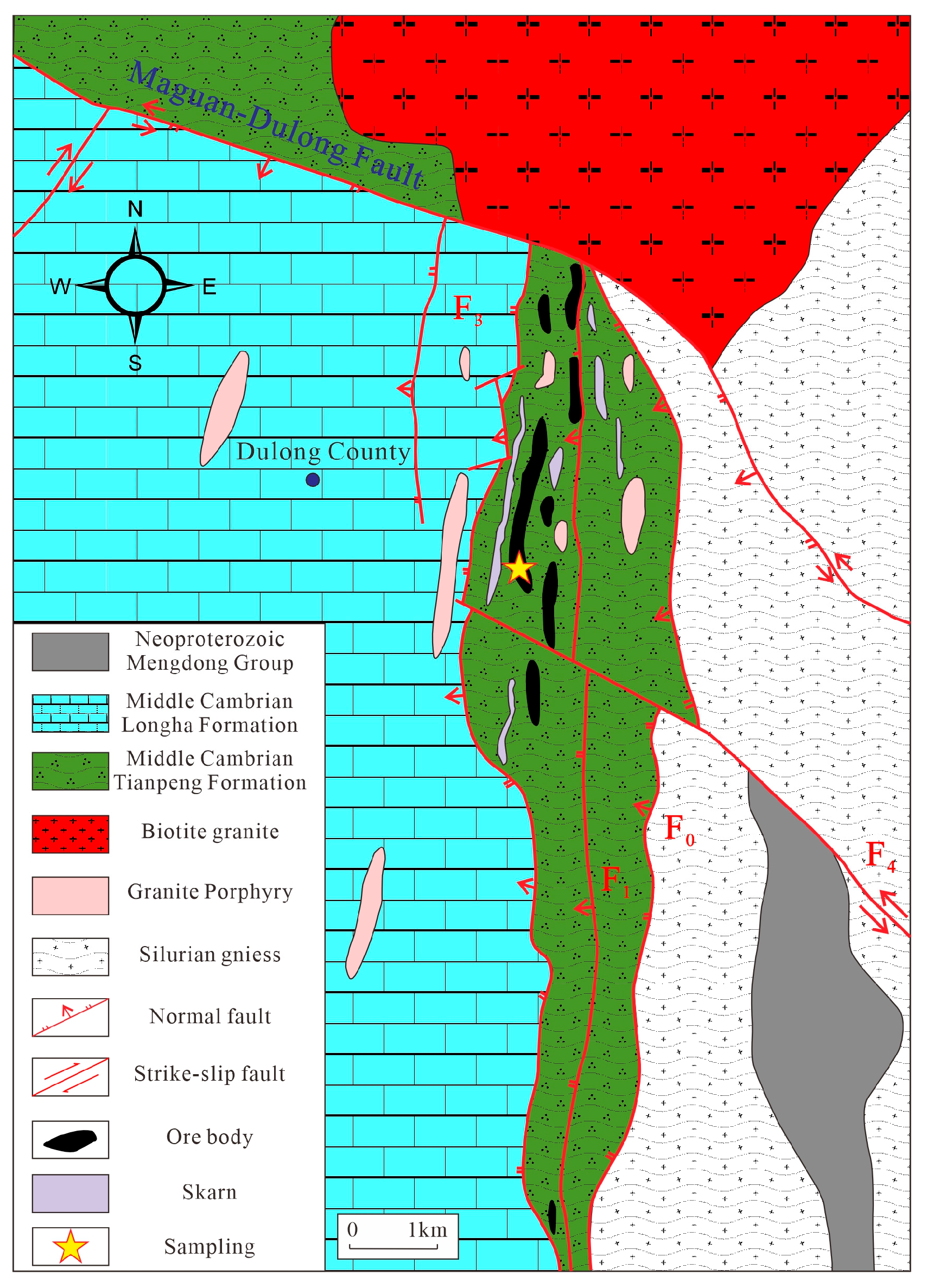
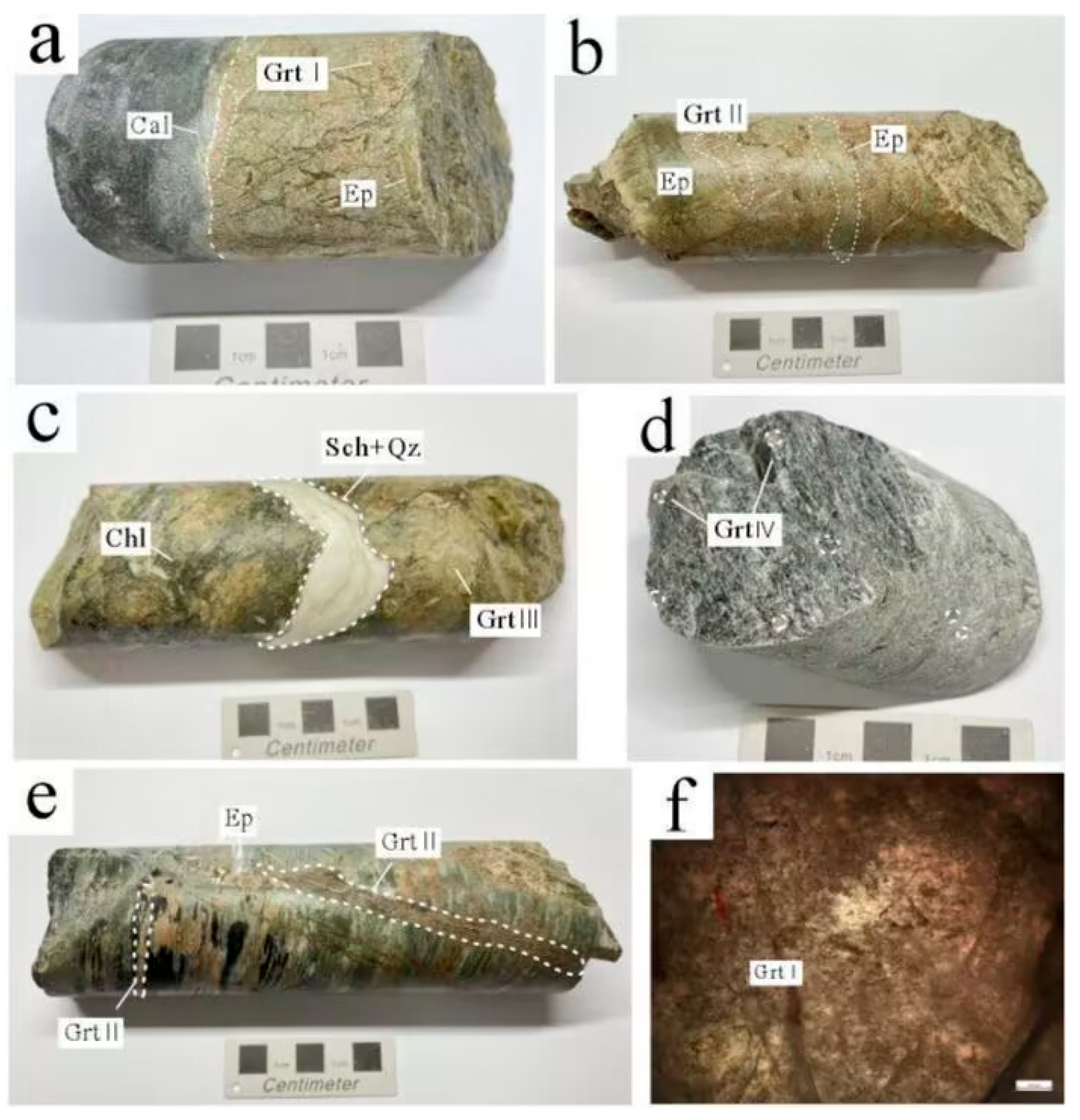

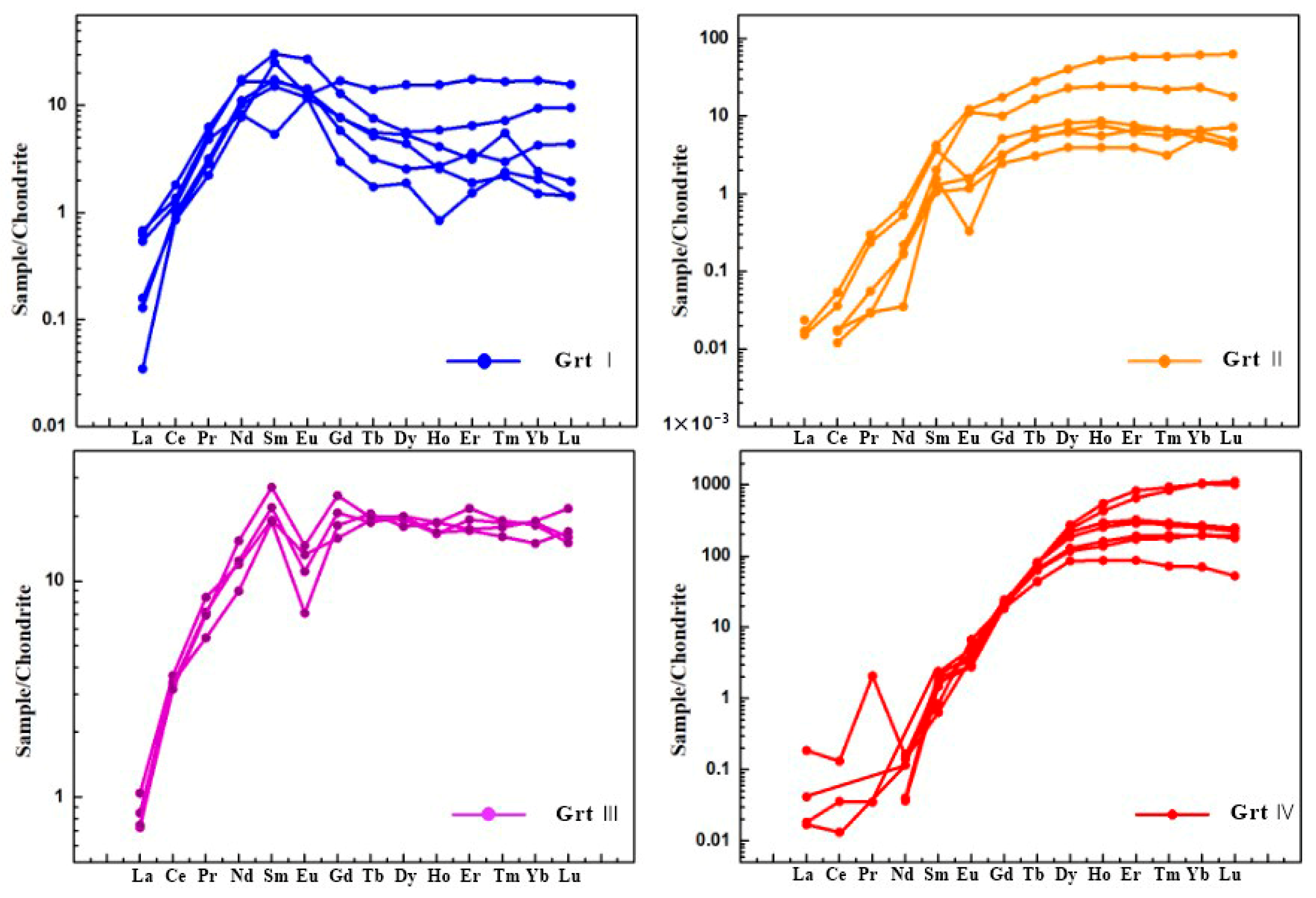
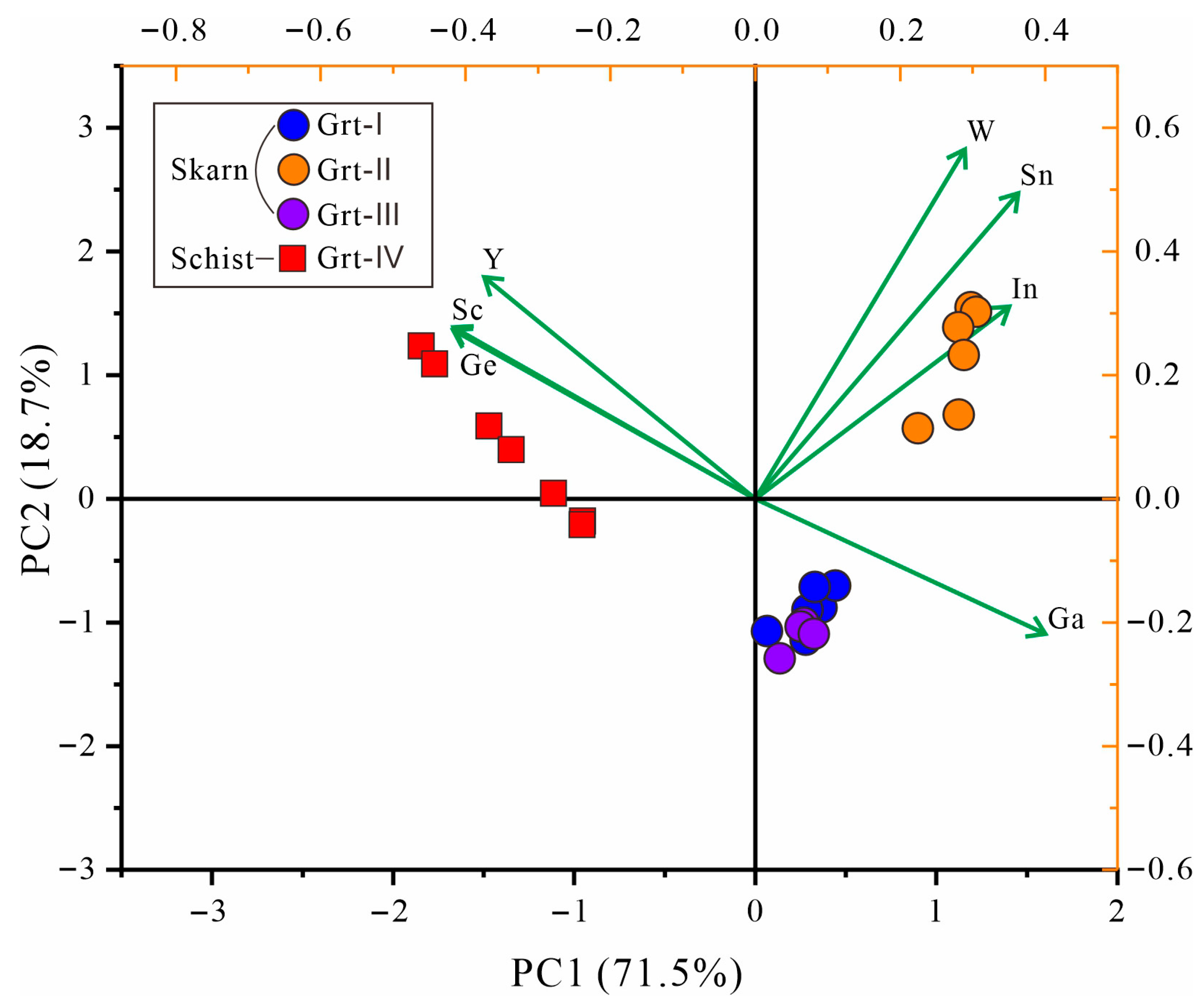
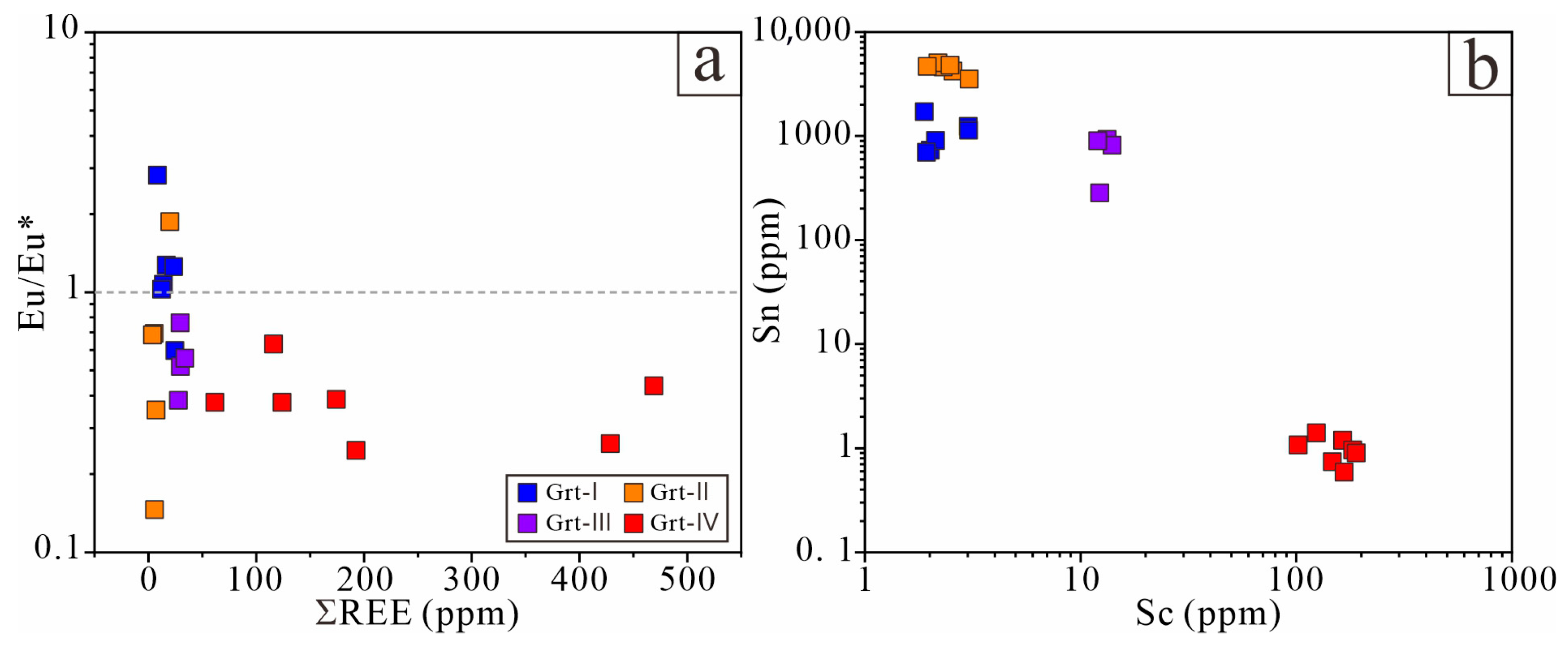
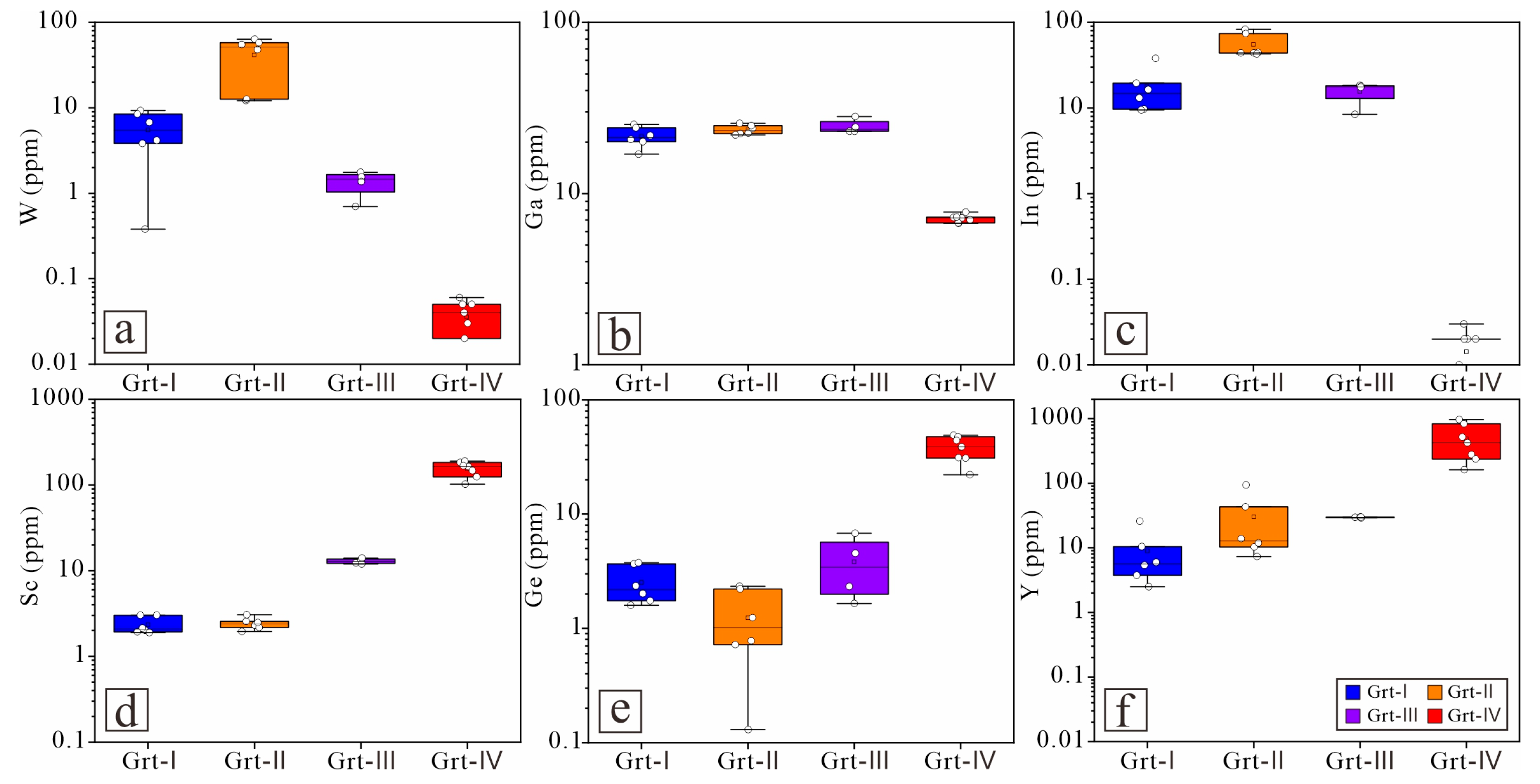
| Number | Mineral | Location | Sampling Depth |
|---|---|---|---|
| 913-6 | Grt-III | Jinshipo | 253.2 m |
| 921-13 | Grt-I | Jinshipo | 185.2 m |
| 125-5 | Grt-II | Jinshipo | 357.8 m |
| 917-2 | Grt-IV | Jinshipo | 54.5 m |
| Sample | Type | SiO2− wt% | TiO2 | Al2O3 | * FeO | MnO | MgO | CaO | Total | *** Si | Ti | Al | ** Fe3+ | ** Fe2+ | Mn | Mg | Ca | **** Gro | And | Pyr | Spe | Alm |
|---|---|---|---|---|---|---|---|---|---|---|---|---|---|---|---|---|---|---|---|---|---|---|
| 921-13-1 | Grt-I | 38.3 | 0.96 | 18.0 | 7.14 | 0.63 | 0.07 | 34.5 | 99.6 | 2.95 | 0.06 | 1.63 | 0.36 | 0.10 | 0.04 | 0.01 | 2.85 | 77.0 | 18.1 | 0.27 | 1.37 | 3.27 |
| 921-13-2 | Grt-I | 38.5 | 0.13 | 16.3 | 9.51 | 0.81 | 0.05 | 34.3 | 99.6 | 2.98 | 0.01 | 1.49 | 0.52 | 0.10 | 0.05 | 0.01 | 2.85 | 69.0 | 25.7 | 0.19 | 1.77 | 3.33 |
| 921-13-3 | Grt-I | 37.4 | 0.13 | 17.9 | 8.08 | 0.69 | 0.05 | 35.4 | 99.7 | 2.90 | 0.01 | 1.64 | 0.43 | 0.10 | 0.05 | 0.01 | 2.94 | 74.5 | 20.6 | 0.19 | 1.47 | 3.20 |
| 921-13-4 | Grt-I | 37.6 | 0.22 | 17.5 | 8.31 | 0.66 | 0.05 | 35.3 | 99.6 | 2.92 | 0.01 | 1.60 | 0.45 | 0.09 | 0.04 | 0.01 | 2.93 | 73.6 | 21.9 | 0.19 | 1.41 | 2.93 |
| 921-13-6 | Grt-I | 38.5 | 0.15 | 18.4 | 7.33 | 0.86 | 0.05 | 34.4 | 99.7 | 2.97 | 0.01 | 1.67 | 0.35 | 0.13 | 0.06 | 0.01 | 2.84 | 76.6 | 17.2 | 0.19 | 1.85 | 4.14 |
| 921-13-7 | Grt-I | 38.9 | 0.01 | 18.2 | 7.44 | 0.70 | 0.06 | 34.2 | 99.5 | 3.00 | - | 1.65 | 0.35 | 0.13 | 0.05 | 0.01 | 2.82 | 76.5 | 17.5 | 0.23 | 1.52 | 4.29 |
| 125-5-1 | Grt-II | 36.7 | 0.81 | 14.6 | 12.1 | 0.93 | 0.06 | 33.8 | 99.0 | 2.90 | 0.05 | 1.36 | 0.68 | 0.12 | 0.06 | 0.01 | 2.86 | 60.5 | 33.2 | 0.23 | 2.04 | 4.03 |
| 125-5-2 | Grt-II | 36.6 | 0.26 | 16.6 | 9.61 | 0.82 | 0.09 | 35.1 | 99.1 | 2.87 | 0.02 | 1.54 | 0.54 | 0.09 | 0.05 | 0.01 | 2.95 | 69.0 | 25.9 | 0.34 | 1.75 | 2.99 |
| 125-5-3 | Grt-II | 37.2 | 0.32 | 15.7 | 10.6 | 0.80 | 0.08 | 34.4 | 99.1 | 2.92 | 0.02 | 1.45 | 0.59 | 0.11 | 0.05 | 0.01 | 2.89 | 65.6 | 28.9 | 0.31 | 1.74 | 3.48 |
| 125-5-4 | Grt-II | 36.9 | 0.84 | 15.1 | 11.5 | 0.98 | 0.06 | 33.8 | 99.2 | 2.90 | 0.05 | 1.40 | 0.63 | 0.13 | 0.07 | 0.01 | 2.85 | 62.4 | 31.1 | 0.23 | 2.14 | 4.12 |
| 125-5-5 | Grt-II | 37.2 | 0.44 | 16.3 | 9.34 | 0.83 | 0.12 | 34.9 | 99.1 | 2.91 | 0.03 | 1.50 | 0.54 | 0.07 | 0.05 | 0.01 | 2.92 | 69.0 | 26.5 | 0.46 | 1.79 | 2.30 |
| 125-5-6 | Grt-II | 37.0 | 0.16 | 16.1 | 10.0 | 0.85 | 0.09 | 34.9 | 99.1 | 2.90 | 0.01 | 1.49 | 0.57 | 0.09 | 0.06 | 0.01 | 2.93 | 67.4 | 27.7 | 0.34 | 1.83 | 2.80 |
| 913-6-1 | Grt-III | 37.0 | 0.66 | 11.0 | 15.3 | 0.57 | 0.13 | 34.7 | 99.4 | 2.93 | 0.04 | 1.03 | 0.99 | 0.03 | 0.04 | 0.02 | 2.95 | 48.3 | 49.0 | 0.51 | 1.26 | 0.83 |
| 913-6-2 | Grt-III | 36.6 | 0.54 | 9.8 | 16.8 | 0.42 | 0.13 | 35.0 | 99.3 | 2.92 | 0.03 | 0.92 | 1.11 | 0.01 | 0.03 | 0.02 | 2.99 | 43.6 | 54.4 | 0.51 | 0.93 | 0.46 |
| 913-6-3 | Grt-III | 36.3 | 0.56 | 9.5 | 17.4 | 0.41 | 0.11 | 35.0 | 99.3 | 2.90 | 0.03 | 0.90 | 1.14 | 0.02 | 0.03 | 0.01 | 3.00 | 41.9 | 56.0 | 0.43 | 0.91 | 0.68 |
| 913-6-6 | Grt-III | 37.1 | 0.52 | 9.4 | 16.8 | 0.43 | 0.10 | 34.9 | 99.3 | 2.96 | 0.03 | 0.89 | 1.12 | - | 0.03 | 0.01 | 2.98 | 43.0 | 55.6 | 0.39 | 0.96 | - |
| 917-2-1 | Grt-IV | 41.0 | 0.08 | 19.8 | 25.5 | 5.67 | 1.20 | 5.88 | 99.1 | 3.25 | - | 1.85 | - | 1.69 | 0.38 | 0.14 | 0.50 | 17.9 | - | 5.11 | 13.7 | 60.9 |
| 917-2-2 | Grt-IV | 40.5 | 0.07 | 20.2 | 27.2 | 4.59 | 1.46 | 5.11 | 99.1 | 3.22 | - | 1.89 | - | 1.81 | 0.31 | 0.17 | 0.43 | 15.3 | - | 6.09 | 10.9 | 63.7 |
| 917-2-3 | Grt-IV | 39.6 | 0.07 | 20.5 | 27.6 | 4.51 | 1.46 | 5.34 | 99.1 | 3.16 | - | 1.93 | - | 1.84 | 0.30 | 0.17 | 0.46 | 15.7 | - | 6.00 | 10.5 | 63.7 |
| 917-2-4 | Grt-IV | 39.8 | 0.08 | 20.3 | 26.7 | 5.22 | 1.34 | 5.61 | 99.1 | 3.18 | - | 1.91 | - | 1.78 | 0.35 | 0.16 | 0.48 | 16.6 | - | 5.56 | 12.3 | 62.2 |
| 917-2-5 | Grt-IV | 38.7 | 0.08 | 20.5 | 25.9 | 6.94 | 1.13 | 5.80 | 99.1 | 3.11 | - | 1.94 | - | 1.74 | 0.47 | 0.14 | 0.50 | 17.1 | - | 4.65 | 16.2 | 59.8 |
| 917-2-7 | Grt-IV | 38.0 | 0.10 | 20.8 | 25.9 | 7.10 | 1.12 | 5.90 | 98.9 | 3.07 | 0.01 | 1.98 | - | 1.75 | 0.49 | 0.13 | 0.51 | 17.1 | - | 4.54 | 16.3 | 58.9 |
| 917-2-8 | Grt-IV | 38.0 | 0.09 | 21.0 | 26.5 | 6.44 | 1.20 | 5.95 | 99.2 | 3.06 | 0.01 | 1.99 | - | 1.78 | 0.44 | 0.14 | 0.51 | 17.1 | - | 4.82 | 14.7 | 59.7 |
| 917-2-9 | Grt-IV | 37.5 | 0.08 | 21.1 | 26.7 | 6.47 | 1.20 | 5.96 | 99.0 | 3.03 | - | 2.01 | - | 1.81 | 0.44 | 0.14 | 0.52 | 17.1 | - | 4.79 | 14.7 | 59.8 |
| Sample | La | Ce | Pr | Nd | Sm | Eu | Gd | Tb | Dy | Ho | Er | Tm | Yb | Lu |
|---|---|---|---|---|---|---|---|---|---|---|---|---|---|---|
| 921-13-1 | 0.04 | 0.52 | 0.21 | 3.62 | 3.86 | 0.73 | 3.49 | 0.53 | 3.96 | 0.88 | 2.91 | 0.43 | 2.91 | 0.40 |
| 921-13-2 | 0.15 | 1.11 | 0.59 | 7.80 | 2.56 | 0.83 | 1.20 | 0.12 | 0.65 | 0.15 | 0.59 | 0.08 | 0.72 | 0.11 |
| 921-13-3 | 0.16 | 0.83 | 0.51 | 8.15 | 4.63 | 1.57 | 2.67 | 0.28 | 1.43 | 0.33 | 1.07 | 0.18 | 1.61 | 0.24 |
| 921-13-4 | 0.03 | 0.61 | 0.30 | 5.19 | 2.67 | 0.78 | 1.57 | 0.21 | 1.35 | 0.23 | 0.52 | 0.14 | 0.41 | 0.05 |
| 921-13-6 | 0.01 | 0.54 | 0.27 | 4.80 | 2.31 | 0.68 | 1.60 | 0.19 | 1.12 | 0.14 | 0.31 | 0.06 | 0.25 | 0.04 |
| 921-13-7 | 0.13 | 0.72 | 0.46 | 3.84 | 0.82 | 0.68 | 0.61 | 0.07 | 0.48 | 0.05 | 0.25 | 0.06 | 0.35 | 0.04 |
| 125-5-1 | - | 0.01 | 0.01 | 0.08 | 0.31 | 0.65 | 2.05 | 0.62 | 5.86 | 1.37 | 3.96 | 0.56 | 3.97 | 0.45 |
| 125-5-2 | 0.01 | - | - | 0.10 | 0.20 | 0.09 | 0.65 | 0.20 | 1.57 | 0.31 | 1.10 | 0.17 | 1.08 | 0.12 |
| 125-5-3 | - | 0.01 | - | 0.02 | 0.24 | 0.02 | 0.65 | 0.19 | 1.66 | 0.43 | 1.02 | 0.14 | 1.12 | 0.18 |
| 125-5-4 | - | 0.03 | 0.03 | 0.33 | 0.64 | 0.71 | 3.58 | 1.05 | 10.2 | 3.01 | 9.59 | 1.50 | 10.4 | 1.59 |
| 125-5-5 | - | 0.02 | 0.02 | 0.25 | 0.56 | 0.09 | 1.06 | 0.25 | 2.06 | 0.49 | 1.26 | 0.17 | 0.87 | 0.10 |
| 125-5-6 | - | 0.01 | - | 0.08 | 0.16 | 0.07 | 0.51 | 0.11 | 1.00 | 0.22 | 0.65 | 0.08 | 0.91 | 0.11 |
| 913-6-1 | 0.25 | 2.23 | 0.80 | 5.57 | 2.92 | 0.77 | 3.24 | 0.72 | 4.89 | 0.94 | 3.18 | 0.47 | 3.17 | 0.41 |
| 913-6-2 | 0.20 | 2.09 | 0.52 | 4.21 | 2.88 | 0.41 | 3.71 | 0.76 | 4.54 | 1.05 | 3.59 | 0.49 | 3.08 | 0.38 |
| 913-6-3 | 0.17 | 2.03 | 0.68 | 5.79 | 3.35 | 0.64 | 4.25 | 0.70 | 5.02 | 0.95 | 2.83 | 0.41 | 2.54 | 0.43 |
| 913-6-6 | 0.18 | 1.93 | 0.66 | 7.16 | 4.15 | 0.84 | 5.11 | 0.74 | 5.06 | 1.06 | 2.87 | 0.45 | 3.22 | 0.55 |
| 917-2-1 | - | - | - | 0.02 | 0.33 | 0.23 | 3.77 | 2.99 | 46.8 | 14.4 | 48.0 | 7.12 | 44.7 | 6.14 |
| 917-2-2 | - | - | - | 0.02 | 0.36 | 0.29 | 4.97 | 2.48 | 32.7 | 9.04 | 31.6 | 5.02 | 33.1 | 4.56 |
| 917-2-3 | - | - | - | 0.08 | 0.13 | 0.39 | 4.20 | 2.34 | 29.8 | 7.78 | 28.6 | 4.51 | 33.5 | 4.88 |
| 917-2-4 | 0.01 | - | - | 0.07 | 0.10 | 0.21 | 3.82 | 1.63 | 21.6 | 4.89 | 14.4 | 1.83 | 11.9 | 1.33 |
| 917-2-5 | - | - | - | 0.02 | 0.23 | 0.26 | 3.92 | 2.97 | 69.4 | 31.0 | 137 | 23.7 | 175 | 25.6 |
| 917-2-7 | 0.04 | 0.08 | - | 0.07 | 0.26 | 0.16 | 3.98 | 2.91 | 61.2 | 24.3 | 108 | 21.2 | 178 | 28.3 |
| 917-2-8 | - | 0.01 | - | 0.05 | 0.30 | 0.17 | 4.48 | 3.07 | 55.2 | 16.6 | 53.5 | 7.46 | 45.6 | 6.31 |
| 917-2-9 | 0.02 | - | - | 0.37 | 0.20 | 4.62 | 3.02 | 55.3 | 16.5 | 52.2 | 6.86 | 42.4 | 5.65 | 29.2 |
| Sample | Type | In | Ga | Ge | Y | Sc | Sn | W |
|---|---|---|---|---|---|---|---|---|
| 921-1 | Grt-I | 13.1 | 25.3 | 3.66 | 25.7 | 3.02 | 1239 | 9.27 |
| 921-2 | Grt-I | 9.67 | 17.0 | 3.75 | 5.36 | 2.01 | 728 | 0.38 |
| 921-3 | Grt-I | 9.49 | 24.2 | 2.35 | 10.4 | 2.13 | 905 | 3.83 |
| 921-4 | Grt-I | 38.0 | 21.8 | 1.74 | 5.94 | 3.03 | 1133 | 4.15 |
| 921-5 | Grt-I | 19.5 | 20.7 | 1.59 | 3.75 | 1.93 | 698 | 8.45 |
| 921-6 | Grt-I | 16.4 | 20.1 | 2.01 | 2.49 | 1.89 | 1711 | 6.77 |
| 125-1 | Grt-II | 83.1 | 25.7 | 2.34 | 43.0 | 2.56 | 4214 | 12.1 |
| 125-2 | Grt-II | 43.8 | 22.6 | 0.13 | 10.3 | 2.31 | 4599 | 63.4 |
| 125-3 | Grt-II | 44.3 | 24.0 | 1.24 | 11.9 | 2.18 | 5039 | 58.0 |
| 125-4 | Grt-II | 74.0 | 22.4 | 2.21 | 93.7 | 3.05 | 3537 | 12.6 |
| 125-5 | Grt-II | 43.8 | 22.0 | 0.72 | 13.8 | 1.95 | 4665 | 54.9 |
| 125-6 | Grt-II | 42.8 | 24.9 | 0.78 | 7.34 | 2.48 | 4779 | 48.0 |
| 913-1 | Grt-III | 8.43 | 23.1 | 2.33 | 29.5 | 12.3 | 284 | 0.70 |
| 913-2 | Grt-III | 18.4 | 23.1 | 1.65 | 29.7 | 13.3 | 928 | 1.76 |
| 913-3 | Grt-III | 17.9 | 24.4 | 4.54 | 29.0 | 14.0 | 812 | 1.55 |
| 913-4 | Grt-III | 17.4 | 28.2 | 6.79 | 29.8 | 12.0 | 896 | 1.37 |
| 917-1 | Grt-IV | 0.02 | 7.19 | 38.8 | 424 | 164 | 1.19 | 0.03 |
| 917-2 | Grt-IV | - | 7.80 | 30.9 | 277 | 147 | 0.74 | 0.05 |
| 917-3 | Grt-IV | 0.02 | 7.03 | 22.1 | 237 | 124 | 1.40 | - |
| 917-4 | Grt-IV | 0.02 | 6.70 | 31.2 | 162 | 102 | 1.07 | 0.02 |
| 917-5 | Grt-IV | 0.01 | 7.25 | 49.1 | 970 | 183 | 0.96 | 0.06 |
| 917-6 | Grt-IV | 0.03 | 6.74 | 47.5 | 834 | 190 | 0.90 | 0.04 |
| 917-7 | Grt-IV | - | 7.29 | 44.1 | 521 | 167 | 0.59 | 0.05 |
| Mineral | Method | Age | MSWD * | Reference |
|---|---|---|---|---|
| Cassiterite | LA-MC-ICP-MS U-Pb | 96.6 ± 3.5 Ma | 8.1 | [27] |
| 93.6 ± 1.6 Ma | 5.8 | |||
| 82.0 ± 2.5 Ma | 11 | |||
| TIMS U-Pb | 79.8 ± 3.2 Ma | 3.2 | [28] | |
| LA-ICP-MS U-Pb | 88.5 ± 2.1 Ma | 1.0 | [10] | |
| 82.1 ± 6.3 Ma | 1.6 | |||
| Zircon | SHRIMP U-Pb | 92.9 ± 1.9 Ma | 0.7 | [28] |
| 86.9 ± 1.4 Ma | 3.7 | |||
| Molybdenite | Re-Os | 83.4 ± 2.1 Ma | - | [29] |
| Garnet | LA-ICP-MS U-Pb | 81.8 ± 1.1 Ma | 2.0 | [16] |
| 81.8 ± 1.8 Ma | 1.6 | |||
| 80.4 ± 2.0 Ma | 1.2 | |||
| Cassiterite | LA-ICP-MS U-Pb | 80.2 ± 0.2 Ma | 1.0 | |
| 79.7 ± 0.6 Ma | 1.2 | |||
| Cassiterite | LA-ICP-MS U-Pb | 85.8 ± 0.5 Ma | 1.5 | [30] |
| Zircon | LA-ICP-MS U-Pb | 85.3 ± 0.4 Ma | 1.7 | [30] |
| 84.7 ± 0.5 Ma | 2.4 |
Disclaimer/Publisher’s Note: The statements, opinions and data contained in all publications are solely those of the individual author(s) and contributor(s) and not of MDPI and/or the editor(s). MDPI and/or the editor(s) disclaim responsibility for any injury to people or property resulting from any ideas, methods, instructions or products referred to in the content. |
© 2025 by the authors. Licensee MDPI, Basel, Switzerland. This article is an open access article distributed under the terms and conditions of the Creative Commons Attribution (CC BY) license (https://creativecommons.org/licenses/by/4.0/).
Share and Cite
Liu, T.; Jiang, S.-Y.; Li, D.-F.; Xiong, S.-F.; Wang, W.; Xiao, S. Geochemical Characteristics and Genetic Significance of Garnet in the Dulong Sn-Polymetallic Deposit, Yunnan Province, Southwestern China. Minerals 2025, 15, 911. https://doi.org/10.3390/min15090911
Liu T, Jiang S-Y, Li D-F, Xiong S-F, Wang W, Xiao S. Geochemical Characteristics and Genetic Significance of Garnet in the Dulong Sn-Polymetallic Deposit, Yunnan Province, Southwestern China. Minerals. 2025; 15(9):911. https://doi.org/10.3390/min15090911
Chicago/Turabian StyleLiu, Tong, Shao-Yong Jiang, Dong-Fang Li, Suo-Fei Xiong, Wei Wang, and Shugang Xiao. 2025. "Geochemical Characteristics and Genetic Significance of Garnet in the Dulong Sn-Polymetallic Deposit, Yunnan Province, Southwestern China" Minerals 15, no. 9: 911. https://doi.org/10.3390/min15090911
APA StyleLiu, T., Jiang, S.-Y., Li, D.-F., Xiong, S.-F., Wang, W., & Xiao, S. (2025). Geochemical Characteristics and Genetic Significance of Garnet in the Dulong Sn-Polymetallic Deposit, Yunnan Province, Southwestern China. Minerals, 15(9), 911. https://doi.org/10.3390/min15090911








